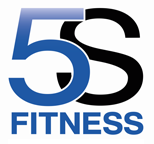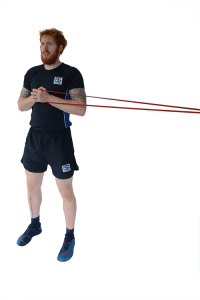The primary action of the core is to provide stability. Therefore, you must first and foremost train your ability to resist the forces that are going to be applying stress to your spine.
There is some controversy around sit-up type exercises, which stems from the fact that repeated bending and twisting of the spine can result in the intervertebral disc fibres cracking and delamination occurring. However, there are many ways to effectively train the core without compromising the health of your lower spine.
One of the best exercises for core development is the Pallof Iso Hold and it’s many variations. These train your ability to resist forces that are trying to side bend and twist your spine – Anti-Rotation and Anti-Lateral Flexion.
The exercise is usually performed as a “pallof press” where you press the resistance band rather than sustaining an isometric hold. However, the pallof iso hold is my favourite anti-rotation exercise.
The pallof iso hold can be performed in various stances while standing or kneeling. These variations should be practised as it will help to build lumbo-pelvic stability in various positions.
1. Use a red band. The tension can be varied by standing closer to, or further away from the band attachment point if required.
2. Attach the band to something solid at chest height, looping the band through itself.
3. Grasp the band with both hands and stand side-on to the attachment point, holding your hands at your chest.
4. Side step away from the attachment point to add tension to the band.
5. Ensure that your feet, hips and shoulders are forward facing. Don’t counter the band tension by turning away from the attachment point.
6. If performing the pallof press, engage your core and press the band to your front, holding it for 2-5 seconds before returning it to the starting position and proceeding with successive reps.
7. For an isometric hold, press the band out and hold it for 30-40 seconds.
8. Complete 2-3 sets of 5-15 reps or 30-40 seconds on each side.
While strength is essential for both good function and overall health of your structure, it’s not effective to develop the muscles that stabilise your structure throughout the day as you would the muscles that facilitate large/explosive movements.
Large primary movers (lats, quads, pecs) respond well to high loads, which ultimately stimulates the greatest strength increases. However, the muscles which help to maintain stability require good endurance and respond well to isometric holds (where there is no change in muscle length i.e. a plank) or high reps with moderate weight. Overloading these muscles with weight can result in primary movers taking over.
Thanks for reading
Jay
Follow us on:
Facebook: www.facebook.com/5sfitnessuk
Twitter: www.twitter.com/5sfitness
Instagram: www.instagram.com/5s_fitness
YouTube: www.youtube.com/channel/UC66XVf9NZBO8j-V4or5d2Tg




